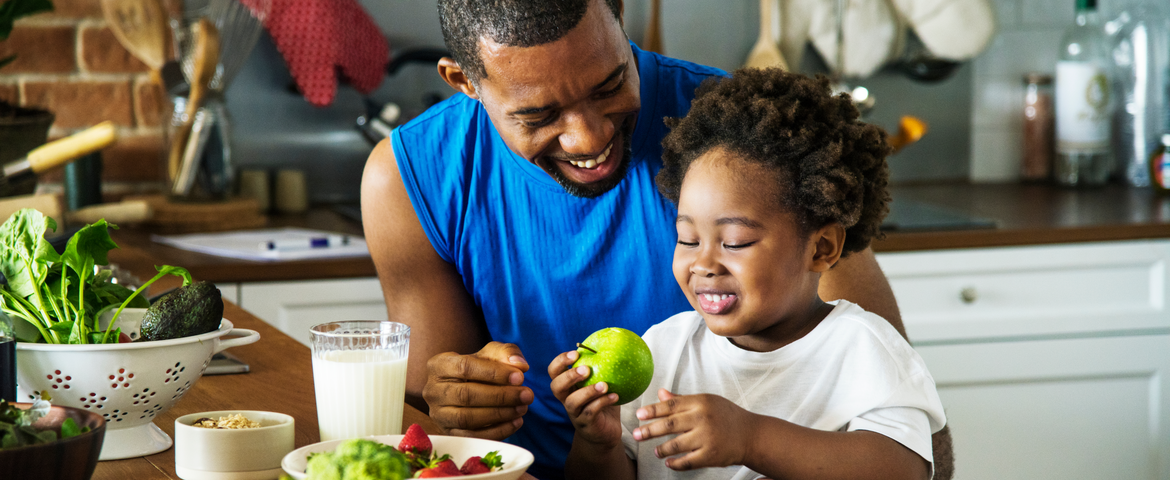By: Rebecca Mason, RDN
As parents and caregivers, we have an immense influence on our kids—and the way we talk about food, our behaviors around food and the way we encourage healthy eating will have a lifelong impact on our children. Here are my five top tips for keeping conversations about food positive and encouraging.
1. Ditch the clean plate club.
Children have a more attuned sense of hunger and fullness than adults, and when we push them to eat beyond what their body needs, we teach them to overeat. It’s your job as a parent to provide nutritious meals and supply an appropriate portion size at the beginning of the meal. Allow your child to stop eating if they tell you they’re full, and allow extra fruits, lean proteins, whole grains and veggies if they’re still hungry. Children’s caloric needs can be far greater than you may expect given their high level of activity and growth—help nourish them with the vitamins, minerals and nutrients their body needs.
2. Practice what you preach.
I know not everyone has a zeal for zucchini. You may not be crazy about cauliflower. Your enthusiasm for eggplant may simply not exist. But, you’re a role model, and even something as simple as saying, “I don’t like that,” can be enough to make your children agree. If you aren’t willing to eat nutritious foods, your “mini me” will likely decide not to as well. Don’t skip the foods you ask your child to eat and keep an open mind—you never know, you might find out you actually DO aspire for some asparagus, after all.
3. Avoid food shaming.
Not long ago, I found myself consoling a young girl who was brought to tears by a single slice of cheese pizza. “My mom told me pizza will make me fat,” she said. The lesson intended was likely about balance, but all she learned was fear. Let’s be real: An occasional serving of a treat doesn’t have a significant impact—long-term habits do. Instead of labeling foods as “good,” “bad,” “healthy,” or “unhealthy,” discuss them as being “everyday” foods (foods you should eat plenty of every day, like vegetables) and “sometimes” foods (occasional treats like sweets or pizza).
Your best bet? Create healthy habits around “sometimes” foods. Kiddos want pizza? Great! Have a slice and make a big, colorful salad to go with it. Have a craving for ice cream? Lovely! Get a scoop and head out for a walk to enjoy some quality time with your family. How rewarding would it be to know that because of you, your kids actually crave salad with pizza or want to get outside for a walk when they have ice cream? Teach your children good habits around “sometimes” foods now, and they’ll benefit from these lessons for a lifetime.
4. Persistence pays off.
Children’s taste buds change and develop over time, so it’s important to keep trying foods, even if it wasn’t an instant favorite the first time. Some studies have shown that it may take 5-10 exposures to a new food for toddlers to accept it, and 10-15 exposures for children ages 3-4. Try introducing new foods with familiar ones helps, vary your cooking methods and seasonings and always encourage taking a bite of something new.
5. Get them involved.
Children love learning in a hands-on manner, so get out and experience food outside of the grocery store. Go to the farmer’s market—it’s a great opportunity to look for something new and exciting to try and learn from the farmers themselves. Let them help in the kitchen with age-appropriate tasks. Even something as simple as growing herbs in a small pot on your windowsill can make children excited about nurturing a plant and trying a new flavor.
You can even take things a step further and use this as an opportunity to talk about the “magic powers” of different foods. For example, did you know leafy greens have calcium? Calcium is great for your bones! How cool is it that strawberries have more vitamin C than an orange? Guess what? Avocado is actually considered a “single-seeded berry.” Leaving out the “healthy” and “unhealthy” verbiage and making simple statements like these can drive curiosity and enthusiasm to learn more about nutrition and the world they live in.
Your health insurance company can also be a resource for additional nutritional resources. At Priority Health, we provide our members with tools such our Wellbeing Hub for tips and tricks including activities or programs based on their specific health plan.
Always explore concerns if you believe your child might be struggling with an eating disorder. For Priority Health members, our Behavioral Health line at 800-673-8043 is available 24/7 and calls are always completely confidential. You can also log in to your member account or our app for more information. Not a Priority Health member? Check with your insurance plan or contact the National Eating Disorders Association for help and additional resources.
Whatever tools you use, remember that it’s important to help your kids have a healthy attitude toward food by being conscious of your own eating habits and how you talk about food. Building a healthy attitude starts when they’re young, but the benefits will last a lifetime.
About the Author: Rebecca Mason, RDN, is a registered dietitian/nutritionist. She is passionate about helping families and individuals improve their health through nutrition education and nutritious food access. Rebecca is certified in adult weight management, and has a background in both clinical nutrition and wellness programming.


